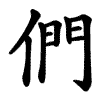們
See also: 们
| ||||||||
Translingual
| Stroke order | |||
|---|---|---|---|
 | |||
Han character
們 (radical 9, 人+8, 10 strokes, cangjie input 人日弓 (OAN), four-corner 27220, composition ⿰亻門)
References
- KangXi: page 107, character 26
- Dai Kanwa Jiten: character 766
- Dae Jaweon: page 229, character 6
- Hanyu Da Zidian: volume 1, page 185, character 2
- Unihan data for U+5011
Chinese
| trad. | 們 | |
|---|---|---|
| simp. | 们 | |
Glyph origin
Phono-semantic compound (形聲) : semantic 亻 (“person”) + phonetic 門 (OC *mɯːn).
Etymology 1
First attested in the Song dynasty (Lü, 1940). Various other glyphs representing *mVn have been attested in Song dynasty texts, including 懣, 滿, 瞞, 門.
It is probably related to 弭 (MC miᴇX) (in 我弭) and 偉 (MC ɦʉiX) (in 兒郎偉) attested in the Tang dynasty (Lü, 1940); it is related to 每 (měi), as in 我每 (wǒměi), common during the Jin dynasty, Yuan dynasty and early Ming dynasty (Lü, 1985).
Proposed etymologies:
- From the personal pronoun plural marker 輩 (OC *puːls) (Lü, 1985; Feng, 1997; Li, 2013).
- From 門 (MC muən, “door; clan; family”) (Ota, 2003; Yu, 1989; Li and Shi, 2000).
- From 每人 (MC muʌiX ȵiɪn, “everybody”) (Norman, 1988); compare Min Dong 各儂/各侬 (“everybody”), used in 我各儂/我各侬 (“we; us”), 汝各儂/汝各侬 (“you (plural)”), 伊各儂/伊各侬 (“they”).
- From 物 (MC mɨut̚, “thing”) (Jiang, 1995).
Also compare 您.
Pronunciation
Definitions
們
- Suffix indicating plural for pronouns, some animated nouns and personifications.
- Suffix attached to the name of the representative of a group to refer to that whole group.
- 總括先生來信的意思,大概有兩點,一是罵史太林先生們是官僚,再一是斥毛澤東先生們的「各派聯合一致抗日」的主張為出賣革命。 [MSC, trad.]
- From: 1936, 魯迅 (Lu Xun) (attributed), 《答托洛斯基派的信》 (Reply to a Letter from the Trotskyites). English translation from
- Zǒngkuò xiānsheng láixìn de yìsi, dàgài yǒu liǎng diǎn, yī shì mà Shǐtàilín xiānshengmen shì guānliáo, zài yī shì chì Máo Zédōng xiānshengmen de “gèpài liánhé yīzhì kàngrì” de zhǔzhāng wéi chūmài gémìng. [Pinyin]
- I take it that the main drift of your letter is contained in these two points: You consider Stalin and his colleagues bureaucrats, and the proposal of Mao Tsetung and others — “Let all parties unite to resist Japan” — as a betrayal of the cause of revolution.
总括先生来信的意思,大概有两点,一是骂史太林先生们是官僚,再一是斥毛泽东先生们的“各派联合一致抗日”的主张为出卖革命。 [MSC, simp.]- 艾奇遜們的欺騙做法在中國還有一層薄薄的社會基礎。 [MSC, trad.]
- From: 1949, 毛澤東 (Mao Zedong), 《丟掉幻想,準備鬥爭》 (Cast Away Illusions, Prepare for Struggle). English translation from
- Àiqíxùnmen de qīpiàn zuòfǎ zài Zhōngguó hái yǒu yī céng bóbó de shèhuì jīchǔ. [Pinyin]
- The deceptive manoeuvres of the Achesons still have a flimsy social base in China.
艾奇逊们的欺骗做法在中国还有一层薄薄的社会基础。 [MSC, simp.]
- (Jin) General suffix indicating plural.
Compounds
Etymology 2
Pronunciation
Definitions
們
- Only used in 們渾/们浑.
Japanese
Kanji
們
- This term needs a translation to English. Please help out and add a translation, then remove the text
{{rfdef}}.
Korean
Hanja
們 • (mun) (hangeul 문, McCune–Reischauer mun)
- This term needs a translation to English. Please help out and add a translation, then remove the text
{{rfdef}}.
Vietnamese
This article is issued from
Wiktionary.
The text is licensed under Creative
Commons - Attribution - Sharealike.
Additional terms may apply for the media files.